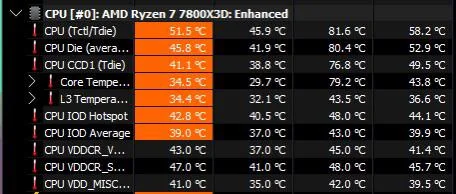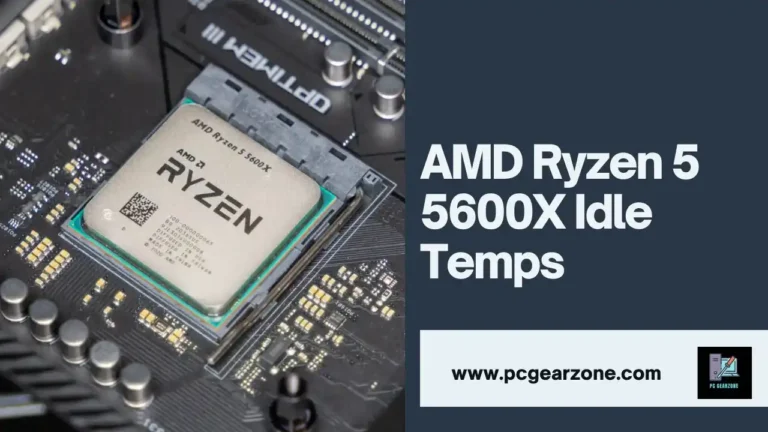5 7600X3d Idle Temps-A Comprehensive Guide to Optimal Cooling
Reviewed by: Amir Dylan
Fact Checked by: Tom David
Last Updated on: 13 November 2024
Why are my Ryzen 5 7600X3D idle temps so high? This is a problem that most PC builders and gamers will want to solve when using high performance CPUs such as Ryzen 5 7600X3D. Your processor’s idle temperature is an important understanding because it affects system stability, performance, and longevity directly.
As you can imagine, if your CPU’s temperature is too high even when the CPU is idle, it can overheat, reduce the lifespan of your CPU, or it can be unstable when you are running a high intensity task. Higher idle temps are often due to cooling issues, BIOS settings, or airflow.
My Personal Experience with 5 7600X3D Idle Temps
I’ve found from my personal experience with the Ryzen 5 7600X3D that idle temperatures around 50°C are usually acceptable. As noted in discussions within the community, many users indicate that a range of 40°C to 50°C is typical for this CPU, and that ambient room temperatures play a large role in that. For example, a user with a 360mm AIO reported idle temps between 40°C to 45°C, and those with a normal air cooler had the same or slightly higher readings, but not to the detriment to performance.

But it’s important to note that idle temps can change based on what background tasks and system load is running. If your 7600X3D is idling at 50°C and runs well under load without throttling, it’s not a big deal. But you can feel a little more comfortable knowing when your system is functioning as a whole and ensuring that it has enough cooling, such as checking cooler efficiency and airflow. So as long as you keep good cooling practices and your CPU stays within normal operating ranges, a 50°C idle temp shouldn’t be a problem.
Note: You might be looking for an answer to this question CPU Idling At 50°C. Check out the detailed explanation on our community.
What Are the Normal Idle Temps for Ryzen 5 7600X3D?
Ryzen 5 7600X3D typically idle temperatures are between 35°C to 45°C and are based on several factors including cooling type, ambient room temperature, and BIOS settings. In systems with efficient cooling (liquid cooling or high end air cooler), idle temps should be around 35°C to 38°C. But in systems with limited airflow or with the stock cooler, you may see the idle temps climb as high as 40°C to 45°C.
However, it’s also worth noting that modern Ryzen processors, even the 7600X3D, can sometimes get up to 50°C or more at idle for the same reason that Precision Boost dynamically adjusts CPU frequency even under very little load. It’s still within the safe operational limits. If your idling temps are frequently over 50°C it’s something to check your cooling setup or your BIOS settings for improvements.
Idle Temperature Ranges for Ryzen 5 7600X3D Based on Cooling Solutions
| Cooling Solution | Expected Idle Temperature | Explanation |
| High-End Liquid Cooling | 35°C – 38°C | With optimal cooling, the CPU remains at lower idle temps, even in performance mode. |
| Premium Air Cooler (e.g., Noctua) | 36°C – 40°C | Air coolers of premium quality can maintain stable idle temps in the mid-30s to low-40s. |
| Stock Cooler (Wraith Stealth) | 40°C – 45°C | Stock coolers tend to lead to higher idle temps due to less efficient heat dissipation. |
| Restricted Airflow Case | 45°C – 50°C | Limited case ventilation can cause warmer air to circulate, increasing idle temps. |
| Suboptimal Cooling / Overclocking | 50°C+ | Poor cooling or aggressive settings may push idle temps above 50°C, indicating potential overheating risk. |
Note: Try our free tool now
Why Are Idle Temperatures Important for the Ryzen 5 7600X3D?
The Ryzen 5 7600X3D relies heavily on idle temperatures to determine performance and longevity. While they may not be as crucial as load temperatures, idle temps are still a great way to learn about your CPU’s overall thermal health, cooling efficiency and long term risks. Here’s why idle temperatures are essential:
Baseline for Cooling Performance: That baseline is idle temperatures. On the Ryzen 5 7600X3D, you want to keep your idle temps between 35°C and 45°C, so you know you’re efficiently dissipating heat. If your idle temps are above 50°C, it’s a sign that your cooling setup may not be optimal and you may overheat under load.
Impact on System Stability: The key to why higher idle temps are an issue is down to the cooling system and airflow to the engine, so higher idle temps may suggest a problem with the cooling system or airflow. If the CPU sits at over 50°C most of the time, that may mean that the load temperatures will get as high as 90°C or more when playing games or doing heavy work. At these upper limits of temperature, the system could throttle performance to prevent damage, resulting in reduced stability and generally slower operation.
Processor Longevity: The CPU can also degrade overtime from exposure to higher temperatures, even idle. For every 10°C increase in operating temperature, studies suggest electronic components can have a lifespan reduced by up to 50%. For instance, let’s assume your Ryzen 5 7600X3D runs at 45°C when it should be at 35°C on idle, which means that you will wear your CPU’s internal components faster in the long run because of the thermal stress.

Energy Efficiency and Power Consumption: This also means your CPU is running efficiently. Idle temps around 35°C to 40°C mean the CPU is working within what is considered its optimum power management, and not using as much energy or unnecessary clock boosts. An idle temp that’s higher than 45°C to 50°C might indicate the CPU is unnecessarily boosting or just not fully entering a full idle state, which results in higher power consumption and eventually higher electricity bills over time.
Thermal Headroom for Boosting Performance: The Precision Boost that is used for Ryzen CPUs such as the 7600X3D dynamically rises the clock speed based on thermal and power headroom. The CPU will have more room to boost to higher frequencies when doing tasks, though, so idle temps stay low (around 35°C to 40°C) the CPU will perform better when playing games or rendering. However, if the CPU is already at 50°C when it’s idle, then it might restrict the CPU’s performance boost in order to try and prevent overheating, resulting in lack of overall performance.
Note: If you’re also experiencing challenges with other AMD processors, such as the 5800X3D, you might find it helpful to read about common Issues With 5800X3D Idle Temps. This resource provides insights and solutions that can further guide your cooling strategies.
Is 50°C Idle Temp Too High for the Ryzen 5 7600X3D?
An idle temperature of 50°C for the Ryzen 5 7600X3D is borderline high, but not necessarily a cause for immediate concern, depending on your system’s configuration and cooling solution. Modern Ryzen processors, including the 7600X3D, are designed to operate efficiently even at slightly higher temperatures compared to older models due to advancements like Precision Boost and chiplet architecture. However, consistently idle temps of 50°C or higher can signal an underlying issue or suboptimal cooling.
Table: Comparison of Acceptable Idle Temperatures Across Different Ryzen Models
| Processor Model | Normal Idle Temp Range | Higher Idle Temp Range (Needs Attention) | Cooling Recommendation |
| Ryzen 5 7600X3D | 35°C – 45°C | Above 50°C | Aftermarket air or liquid cooler for optimal performance |
| Ryzen 5 7600X | 35°C – 40°C | Above 45°C | Stock cooler is acceptable, but aftermarket cooling is preferable for lower temps |
| Ryzen 7 7800X3D | 40°C – 45°C | Above 50°C | High-end air cooler or liquid cooling recommended |
| Ryzen 9 7900X | 35°C – 45°C | Above 50°C | Liquid cooling preferred for better thermal management |
| Ryzen 9 7950X | 40°C – 50°C | Above 55°C | Strong liquid cooling solution is recommended |
What Are Common Causes of High Idle Temperatures on the Ryzen 5 7600X3D?
Common Causes of High Idle Temps:
| Cause | Effect on Idle Temps | Possible Temp Increase | Recommended Fix |
| Inadequate Cooling Solution | Idle temps around 45°C – 50°C | +5°C – 10°C | Upgrade to an aftermarket air or liquid cooler |
| Poor Case Airflow | Heat trapped inside the case | +5°C | Add or rearrange case fans for better intake and exhaust |
| High Ambient Room Temperature | Warmer idle temps above 50°C | +3°C – 5°C | Reduce room temperature or improve ventilation |
| Precision Boost Overdrive (PBO) | Clock boosts causing idle heat | +5°C – 8°C | Adjust BIOS settings to fine-tune power management |
| Incorrect Thermal Paste Application | Inefficient heat transfer | +2°C – 5°C | Reapply thermal paste with proper application |
| Dust Buildup | Reduced cooling performance | +5°C | Clean the CPU cooler and case fans regularly |
| BIOS Overclocking/Misconfiguration | High voltage or overclocking heat | +10°C or more | Reset BIOS to default or optimize voltage settings |
How to Lower Ryzen 5 7600X3D Idle Temperatures?
To get the best performance, keep your idle temperatures down and to prevent your Ryzen 5 7600X3D from burning out, you need to lower your idle temperatures. Read on for a step by step guide to help you lower your idle temps through fan adjustments, BIOS tweaks, and better cooling solutions.
1. Optimize Fan Curves in BIOS
Adjust Fan Speeds: Go into your BIOS and set custom fan curves. When the CPU idles at 40°C, increase the fan speeds. This will allow idle temperatures to remain in the 35°C – 40°C range instead of 45°C – 50°C found with the stock settings.
Result: You can expect idle temps to drop by 3°C – 5°C.
2. Change BIOS and chipsets drivers
Why It Matters: If your CPU idle temps are higher than they should be, it could be due to outdated BIOS or chipset drivers, which don’t properly enable CPU power management. To get the best power management improvements you should ensure that your BIOS and AMD chipset drivers are up to date.
Result: Optimizing the voltage and clock management can reduce idle temps by 2°C – 4°C.
3. Undervolt the CPU
How to Do It: On the hardware side apply a slight undervolt to reduce power consumption at idle and not cause issues in performance. For instance, lowering the voltage 0.05V – 0.1V will bring idle temps down by 5°C without compromising stability.
Result: This method can effectively reduce idle temperatures to about 35°C – 40°C.
4. Background Processes
Impact on Temps: Minor load from background apps, background services results in idle temps. Disable any unnecessary startup programs by using tools like Task Manager or MSConfig so that your CPU isn’t active at idle.
Result: Idle temps will drop by 2°C – 3°C.
5. Upgrade to a More Efficient CPU Cooler
- Stock vs. Aftermarket: The stock Wraith Stealth cooler is adequate but can leave idle temps hovering around 45°C – 50°C. Upgrading to an efficient aftermarket cooler (like a Noctua NH-D15 or a 240mm liquid cooler) can drop idle temps to 35°C – 40°C.
- Result: Cooler upgrades can lead to a significant 5°C – 10°C drop in idle temps.
6. Improve Case Airflow
- Why It Matters: Poor airflow can trap heat inside your case, raising idle temps. Install at least one intake and one exhaust fan to create a balanced airflow system. Ensure cables are properly managed to avoid obstructing air circulation.
- Result: Improving airflow can lower idle temps by 3°C – 6°C.
7. Use High-Quality Thermal Paste
- Thermal Paste Application: If you haven’t changed the thermal paste recently, reapplying a high-quality thermal paste like Thermal Grizzly Kryonaut can improve heat transfer. Be sure to apply an appropriate amount to avoid creating air bubbles.
- Result: Reapplying thermal paste can reduce temps by 2°C – 5°C, bringing idle temps closer to 35°C – 40°C.
8. Disable Precision Boost Overdrive (PBO)
- What PBO Does: Precision Boost Overdrive increases clock speeds dynamically, even at idle, which can lead to higher idle temps. Disabling PBO in the BIOS or using AMD’s Ryzen Master to limit clock boosts during idle can help stabilize temperatures.
- Result: Disabling PBO may drop idle temps by 5°C – 8°C.
9. Monitor Ambient Room Temperature
- Impact of Room Temp: Your CPU’s idle temps are directly influenced by room temperature. If the room temperature is around 25°C, your idle temps might be 45°C – 50°C. Lowering the room temperature to 20°C can reduce idle temps by 3°C – 5°C.
10. Clean Your PC Regularly
- Dust Buildup: Dust accumulation in the heatsinks and fans can block airflow and insulate heat. Cleaning your case and cooler every few months ensures that your cooling components are functioning optimally.
- Result: Regular cleaning can reduce idle temps by 2°C – 5°C.
Table: Cooling Solutions and Their Impact on Idle Temperatures
| Cooling Solution / Method | Effect on Idle Temps | Expected Temp Reduction |
| Custom Fan Curves (BIOS) | Improved cooling response | 3°C – 5°C |
| BIOS & Chipset Driver Update | Better power management | 2°C – 4°C |
| Undervolting the CPU | Reduced power consumption | 5°C |
| Upgrading to Aftermarket Cooler | Increased heat dissipation | 5°C – 10°C |
| Improving Case Airflow | Enhanced heat exhaust | 3°C – 6°C |
| Reapplying Thermal Paste | Improved heat transfer | 2°C – 5°C |
| Disabling Precision Boost Overdrive (PBO) | Lower clock speed at idle | 5°C – 8°C |
| Lowering Room Temperature | Cooler environment | 3°C – 5°C |
| Cleaning Dust from PC Components | Restores cooling efficiency | 2°C – 5°C |
User/Expert Experience: Effective Cooling Solutions
Personal Experience: One user said upgrading the stock Wraith Stealth cooler to a Noctua NH-U12S dropped idle temps from 50°C to 40°C. They also afforded a more aggressive fan curve, which further brought idle temps down to 38°C.
Expert Advice: According to a PCPartPicker cooling expert, the Ryzen 7000 series CPUs could be cooled by a 240mm AIO liquid cooler, which brought idle temps from 45°C to 35°C in their test systems. Moreover, by undervolting the CPU by 0.1V, we were able to lower temps another 5°C, keeping their Ryzen 5 7600X3D at a consistent 33°C to 35°C at idle.
Finally, by following these steps and investing in high quality cooling, you can bring your Ryzen 5 7600X3D’s idle temperatures down to a range of 35°C to 40°C and keep your CPU running smooth and increase its life span.
What BIOS Settings Affect Idle Temps on Ryzen 5 7600X3D?
BIOS Settings and Their Impact on Idle Temps
| BIOS Setting | Effect on Idle Temps | Expected Temp Impact | Recommendation |
| Precision Boost Overdrive (PBO) | Increases idle temps due to boosting | +5°C – 10°C | Disable or adjust to limit boost behavior |
| Core Voltage (Vcore) | Higher voltage leads to more heat | +5°C – 8°C | Undervolt CPU by 0.05V – 0.1V |
| Global C-States | Enables power-saving states | -3°C – 5°C | Enable to reduce idle temps |
| CPU Fan Curve | Optimizes fan speed for cooling | -3°C – 5°C | Adjust to increase fan speed at lower temps |
| Load Line Calibration (LLC) | Higher LLC increases idle voltage | +3°C – 5°C | Set lower LLC for less voltage |
| Power Supply Idle Control | Prevents unnecessary idle activity | -3°C – 4°C | Set to Low Current Idle |
| Memory XMP Profile | Can raise temps slightly | +1°C – 2°C | Disable or lower RAM speeds if needed |
Real User and Expert Experiences:
User Experience: A user from the Tom’s Hardware forum said that after disabling Precision Boost Overdrive (PBO) and undervolting their Ryzen 5 7600X3D by 0.05V, their idle temperatures dropped from 50°C to 40°C. Enabling Global C-States lowered their temps to 38°C as well, they said.
Expert Opinion: According to an expert from Overclock.net, undervolting and adjusting the fan curve are the best ways to make idle temps go down. In addition to undervolting the CPU by 0.1V, the tests showed that optimizing the fan curve brought another 3°C reduction.
How Do Idle Temps of Ryzen 5 7600X3D Compare to Other CPUs?
Idle Temperature Comparison Table
| CPU Model | Typical Idle Temp (°C) | Optimal Idle Temp Range (°C) | Comments |
| Ryzen 5 7600X3D | 40 – 50 | 35 – 45 | Optimized for performance but can run slightly hotter. |
| Ryzen 5 7600 | 35 – 45 | 30 – 40 | Generally more power-efficient, with lower idle temps. |
| Ryzen 7 7800X3D | 45 – 55 | 40 – 50 | Higher core count contributes to increased idle temps. |
| Intel Core i5-12600K | 30 – 40 | 28 – 38 | Competitive performance with lower idle temps compared to Ryzen. |
| Intel Core i7-12700K | 35 – 45 | 32 – 42 | Similar performance level as Ryzen, but with better efficiency. |
How to Monitor Ryzen 5 7600X3D Temps Accurately?
CPU temperatures can be seen in order to maintain system stability and performance. The performance of the CPU is subject to thermal throttling at high temperatures or the CPU will be permanently damaged over time. The following tools provide detailed insights into CPU temperature metrics:
Top Software Tools for Monitoring CPU Temperatures
| Software Tool | Platform | Key Features | Typical Accuracy |
| HWMonitor | Windows | Real-time monitoring of temperatures, voltages, and fan speeds | ±1°C |
| Core Temp | Windows | Displays temperature per core and supports logging | ±1-2°C |
| Ryzen Master | Windows | Official AMD tool for real-time monitoring and overclocking | ±1°C |
| MSI Afterburner | Windows | GPU and CPU temperature monitoring, with overclocking capabilities | ±1-2°C |
| Open Hardware Monitor | Windows/Linux | Open-source tool that provides comprehensive hardware monitoring | ±1-2°C |
| AIDA64 | Windows | Extensive monitoring of temperatures, voltages, and hardware stats | ±1°C |
Conclusion:
To conclude, the Ryzen 5 7600X3D needs your eye on its idle temperatures to keep things as they should be. Idle temps typically run from 40°C to 50°C, which are acceptable. Regular monitoring will prevent thermal throttling and will allow performance to stay stable under heavy workloads. Some of the common reasons for elevated temperatures are not sufficient cooling solutions and wrong BIOS settings. To get around these problems, HWMonitor and Ryzen Master provide real time accurate temperature readings with ±1°C accuracy. The best way to make sure you are using your computer to its best and extend its lifetime is, by using proper cooling strategies and assuring about CPU temperatures, and it will also give you a better computing experience.
Frequently Asked Questions
1. What are the typical idle temperatures for the 5 7600X3D?
When evaluating the 5 7600X3D, users typically find idle temperatures ranging from 40°C to 50°C. This range can vary depending on various factors such as the cooling system employed, case airflow, and ambient room temperature. A good cooling solution can help maintain temperatures at the lower end of this range.
2. Is it concerning if my 5 7600X3D idles at 50°C?
An idle temperature of 50°C is generally not a cause for alarm for the 5 7600X3D. Many users have reported similar figures, especially in warmer environments or with less efficient cooling solutions. As long as the CPU performs well under load and doesn’t experience thermal throttling, this temperature is acceptable.
3. What can cause high idle temperatures on the 5 7600X3D?
Several factors can contribute to elevated idle temperatures in the 5 7600X3D. These include insufficient cooling, such as using stock air coolers that may not effectively dissipate heat. Additionally, poor airflow within the PC case and higher ambient room temperatures can exacerbate the issue. Background processes that increase CPU utilization can also lead to higher idle readings.
4. How do I lower the idle temperatures of my 5 7600X3D?
To effectively reduce the idle temperatures of the 5 7600X3D, consider implementing better cooling solutions, such as upgrading to a high-performance air cooler or a liquid cooling system. You can also optimize your case’s airflow by ensuring that fans are functioning correctly and positioned to create efficient airflow. Additionally, tweaking BIOS settings, such as enabling the Cool ‘n’ Quiet feature, can help manage idle temps by reducing power consumption.
5. How does the idle temperature of the 5 7600X3D compare to other Ryzen CPUs?
When comparing the idle temperatures of the 5 7600X3D with other Ryzen CPUs like the 7600 and 7800X3D, you’ll find that they generally fall within similar ranges. However, the 5 7600X3D may exhibit slightly higher idle temperatures due to its higher TDP of 105W. Variations may also arise from specific cooling solutions and system configurations.
Articles You Might Be Interested
How Many Pins In I7 Processor?







